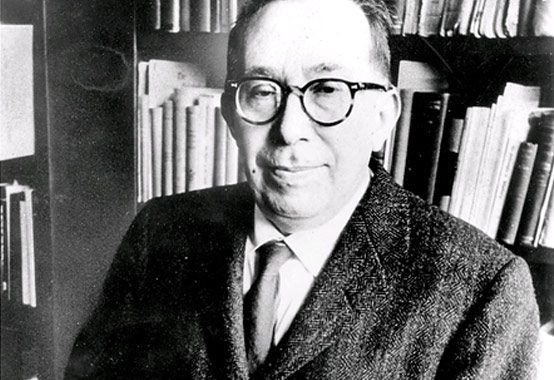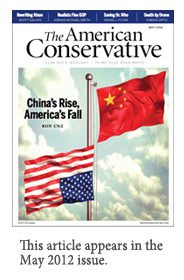jeudi, 14 février 2013
The Right’s False Prophet
The Right’s False Prophet
Review of: Leo Strauss and the Conservative Movement in America, Paul Gottfried, Cambridge University Press, 182 pages

When writing about the work of an academic historian or philosopher—as opposed to a polemicist, a politician, or a popularizer—there is an obvious threshold question with which to begin: is the writer’s work intrinsically interesting or compelling in some way? If this question is answered in the negative, then there is usually no reason to carry on.
The strange case of Leo Strauss, however, proves that there are definite exceptions to this rule. Strauss’s work is almost universally dismissed by philosophers and historians, yet he has attracted a following amongst political theorists (hybrid creatures most often associated with political science departments) and neoconservative political activists. So, while the verdict on the intellectual importance of Strauss’s historico-philosophical work has been that, like Gertrude Stein’s Oakland, there is no there there, the practical influence of Strauss, its manifestation as Straussianism, and Straussianism’s connection with neoconservatism still present themselves as intriguing problems in contemporary American intellectual history.
In Leo Strauss and the Conservative Movement in America Paul Gottfried, the Horace Raffensperger Professor of Humanities at Elizabethtown College, offers an explanation of the Straussian phenomenon that is concise and compelling. While treating Strauss’s work with considerable respect, Gottfried concludes that the historians’ and philosophers’ rejection of Strauss is, for the most part, justified. However, unlike critics on the left who suggest that Strauss is illiberal and anti-modern, Gottfried argues that Strauss’s appeal consists largely in his creation of a mythical account of the rise of liberal democracy and its culmination in a creedal conception of the American polity.
According to Gottfried, Strauss and his followers have always been more concerned with practical questions about contemporary politics than with intellectual history or complex philosophical questions. Their primary purpose, which allies the neoconservatives with them, is to develop an abstract legend of American politics that supports a moderate welfare state domestically and a quasi-messianic internationalism in foreign policy.
Gottfried comes to these conclusions from several directions. First, he offers an engaging contextual account of Strauss’s intellectual formation. Gottfried argues that three biographical facts are central to understanding Strauss’s work: “he was born a Jew, in Germany, at the end of the nineteenth century.” Strauss’s most important early intellectual encounter was with the neo-Kantian Hermann Cohen, who attempted to make Kant safe for Judaism and vice versa. Strauss was also influenced by Cohen’s sharply critical reading of Spinoza as a proto-liberal intent on conceiving of political life in a secular way that would allow for the successful assimilation of the Jewish people. According to Gottfried, “a profound preoccupation with his Jewishness runs through Strauss’s life” and plays a major role in Strauss’s development into an apologist for an ideological and universalist version of liberal democracy.
Strauss was also influenced by the intellectual battles being waged in Germany at the turn of the century. The Methodenstreit that was taking place amongst economists was also occurring amongst historians and philosophers, and it resulted in a series of conceptual dichotomies that would appear throughout Strauss’s later writings. His trio of bêtes noires (positivism, relativism, and historicism) was at the heart of the conflicts about methodology in Germany, and the outcome of these debates set the terms of critique for Strauss’s youth and beyond.
Finally, there was the political situation in Germany, especially after the disastrous end of World War I. The attractions of fascism to someone like Strauss, whose early inclinations were in a more social-democratic direction, would have been obvious, given the instability of Weimar. Nonetheless, it is unlikely that Strauss’s admiration for Mussolini outlasted the mid-1930s. Instead, the lesson that Strauss took from the fall of the Weimar government and the rise of Hitler and National Socialism was that liberalism was not capable of withstanding the onslaught of historicism, positivism, and moral relativism without solid quasi-religious and quasi-mythical foundations—and that he would be the one to provide those. Gottfried is certainly correct in arguing that for Strauss and his acolytes it is always September 1938 and we are always in Munich.
The second direction from which Gottfried approaches Strauss leads through an examination of the Straussian method and its products. Gottfried provides a critical account of the method and also notes the ahistorical, quasi-legendary, and often hagiographic character of the interpretations that the method produces. The Straussian method consists of two distinct doctrines, neither of which is particularly clear or convincing. First, Strauss asserts that understanding the work of a philosopher involves the reproduction of the author’s intention. Unfortunately, and as Gottfried argues, Strauss never explains what he means by “intention,” nor does he explain how one might reproduce an author’s intention. The second doctrine, however, renders the first irrelevant. Strauss argues that authentic philosophers hide their teaching from the casual reader and only initiates into the true philosophic art can decode the esoteric meaning of such texts. For Strauss and the Straussians, this is not an historical claim but a theoretical one, and it yields an interpretative strategy both naïve and paranoid.
The results of the Straussian method read like they were written by the intellectual offspring of Madame Blavatsky and Edgar Bergen. It may seem difficult to distinguish between the oracular pronouncements and the intellectual ventriloquism, but that’s because there is no real distinction to be made. As Gottfried notes, there is uncanny similarity between the Straussian reading of texts and the postmodern deconstruction of language. The esoteric claims provide cover for Straussian interpretive preferences and shield against criticism from anyone outside the clique. Cleanth Brooks once imagined what postmodern literary critics could have made of “Mary Had a Little Lamb,” and it makes just as much sense to ask what the Straussians could do with the nursery rhyme.
The two primary conclusions associated with Strauss’s esoteric reading of past texts are that all philosophers from the time of Plato onward were atheistic hyper-rationalists and that the United States emerged fully formed from the forehead of John Locke. Both of these conclusions are historically false, but it is inaccurate to call Strauss or his epigones bad historians because they are not historians at all.
Gottfried suggests correctly that Strauss and his followers are, in fact, engaged not in historical scholarship but in offering an extended civics lesson. He writes that the “celebration of the American present, as opposed to any march into the past, is a defining characteristic of the Straussians’ hermeneutics.” The Straussian professor understands himself as a prophet, a preacher, and a proselytizer, and at least in this consideration there is a significant element of commonality with the academic left. The Straussian past is composed of a collection of heroes and villains, and the story describes a teleological development of political life culminating in a highly abstract and ideologized version of the United States. This legend of American politics has proven to be the most influential of Strauss’s various tales of the mighty dead.
In his third approach to Strauss, Gottfried offers an appraisal of the influence of Straussianism on American politics generally and on American conservatism specifically. It is here that Gottfried makes what will likely be considered his most controversial arguments. He suggests that Strauss and the Straussians are best understood not as conservatives but as Cold War liberals and that their natural allies are the so-called neoconservatives. There are two Strausses and Straussianisms here. There are the West Coast Straussians (Harry Jaffa, Charles Kesler, and the Claremont crew), who read the master as a true-believing liberal democrat, and there are the East Coasters (Harvey Mansfield, Allan Bloom, Thomas Pangle, et al.) who view him as liberal democrat faute de mieux. However, as Gottfried points out, the similar practical conclusions reached by the two schools make the differences between them unimportant.
Indeed, one of the implicit claims that Gottfried makes is that there is not that great of an ideological difference between the American political parties, and there is no difference between neoconservatives and Cold War liberals. Thus the influence of the Straussians derives in part because, despite their sometimes bombastic rhetoric, their politics are center or center-left and not much different from the politics of both of the mainstream warfare/welfare-state parties in America.
Gottfried notes that both the Straussians and the neoconservatives “assume a certain right-wing style without expressing a right-wing worldview.” Neoconservatives serve to popularize the Straussians’ mythical account of American politics by “drawing their rhetoric and heroic models from Straussian discourse.” Staussians, on the other hand, profit from neoconservative largesse. Gottfried writes that the Straussians “have benefited from the neoconservative ascendency by gaining access to neoconservative-controlled government resources and foundation money and by obtaining positions as government advisors.”
For Gottfried, the primary effect that both neoconservatives and Straussians have had on the American conservative movement is to suck all the air out of it and ensure that there is no one to the right of them, while their primary effect on American politics generally has been to reinforce the ideologically charged notion that America is some sort of propositional nation constituted like a vast pseudo-religion by a set of tenets needing constant promulgation. It is a story of America as armed doctrine, and Gottfried is assuredly right in arguing that there is nothing conservative about it.
Strauss was at best a mediocre scholar whose thought expressed a confused bipolarity between a very German and ahistorical Grecophilia on the one hand and a scattered, dogmatic, and unsophisticated apology for an American version of liberal universalism on the other. Amongst prominent European philosophers, Strauss was taken seriously only by Hans-Georg Gadamer, until Gadamer concluded that Strauss was a crank, and by Alexandre Kojève, whose work reads today as if it were a parody of trendy French Marxism. In Britain, neither Strauss nor the Straussians have ever been taken seriously.
Strauss’s argument about esotericism is both historically and philosophically incoherent and useless in any methodological sense. It calls to mind something that Umberto Eco called cogito interruptus:
cogito interruptus is typical of those who see the world inhabited by symbols or symptoms. Like someone who, for example, points to the little box of matches, stares hard into your eyes, and says, ‘You see, there are seven…,’ then gives you a meaningful look, waiting for you to perceive the meaning concealed in that unmistakable sign.
Finally, regarding the phenomenon of Straussianism, the cult took hold here for the same reasons that cults generally succeed in the U.S.: ignorance, inexperience, and a desire to have a simple answer to complex problems.
Kenneth B. McIntyre is assistant professor at Concordia University in Montreal and is the author of Herbert Butterfield: History, Providence, and Skeptical Politics.
00:05 Publié dans Philosophie, Théorie politique | Lien permanent | Commentaires (0) | Tags : leo strauss, états-unis, droite, droite américaine, théorie politique, philosophie, politologie, sciences politiques |  |
|  del.icio.us |
del.icio.us |  |
|  Digg |
Digg | ![]() Facebook
Facebook




Les commentaires sont fermés.